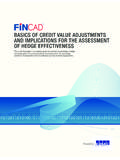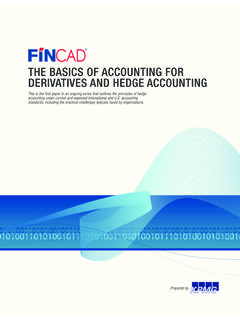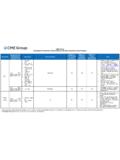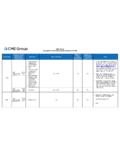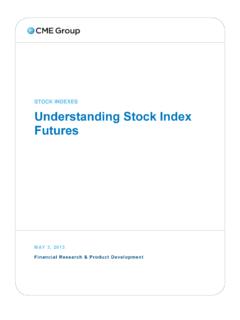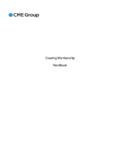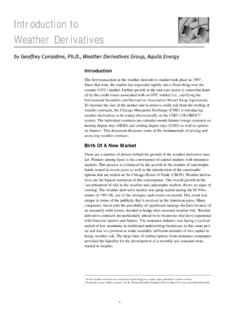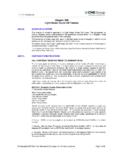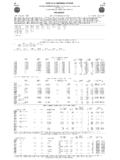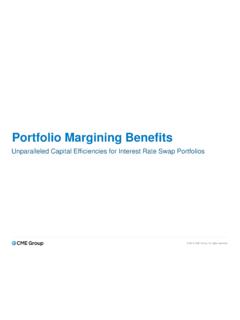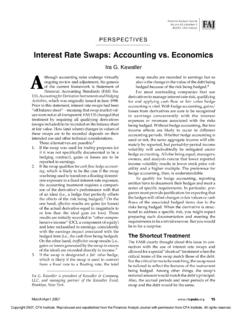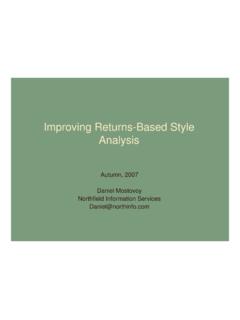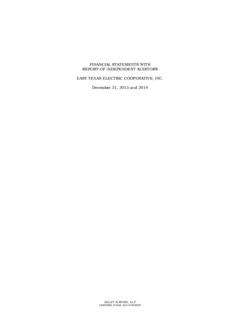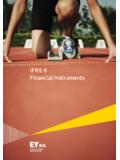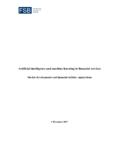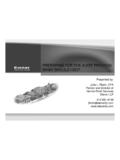Transcription of Basics of Hedge effectiveness testing and …
1 Basics of Hedge effectiveness testing and measurement This is the second paper in an ongoing series that outlines the principles of Hedge accounting under current and expected International and accounting standards, including the practical challenges typically faced by organizations. Prepared by Basics of Hedge effectiveness testing and measurement Accounting Treatment Mismatch Under International and accounting standards, assets and liabilities not classified or designated as held for trading and measured at fair value through profit or loss are subject to measurement at amortized cost or fair value through Other Comprehensive Income (OCI). Derivative financial instruments, however, are always subject to measurement at fair value through profit or loss.
2 As a result, an accounting treatment mismatch can occur when an organization uses derivative financial instruments (hedging items or hedging instruments) to Hedge against exposures to a market risk arising from an underlying asset or liability that is not measured at fair value through profit or loss (hedged items). In these instances, the accounting mismatch is due to the different basis of accounting between the hedged item and the hedging instrument, giving rise to volatility in the income statement. Hedge accounting is intended to deal with this accounting mismatch. By adjusting the basis of accounting for the hedged item (Fair Value Hedge ) or the hedging item (Cash Flow Hedge ), organizations can effectively use Hedge accounting to reduce income statement volatility.
3 One of the critical requirements necessary to apply Hedge accounting is the need to demonstrate that the Hedge relationship will be (and has been) highly effective through the term of the relationship. Highly effective does not imply that the Hedge needs to be perfectly effective; a certain amount of noise or ineffectiveness is permissible, as detailed further below. What is Hedge effectiveness ? Hedge effectiveness is the extent to which changes in the fair value or cash flows of the hedging instrument offset the changes in the fair value or cash flows of the hedged item. Conversely, Hedge ineffectiveness is the measure of the extent to which the change in the fair value or cash flows of the hedging instrument does not offset those of the hedged item.
4 Under both International and accounting standards, there is a requirement to test Hedge effectiveness on both a prospective and a retrospective basis. The prospective Hedge effectiveness test is a forward-looking evaluation of whether or not the changes in the fair value or cash flows of the hedging item are expected to be highly effective in offsetting the changes in the fair value or cash flows of the hedged item over the term of the relationship. On the other hand, the retrospective Hedge effectiveness test is a backward-looking evaluation of whether the changes in the fair value or cash flows of the hedging item have been highly effective in offsetting changes in the fair value or cash flows of the hedged item since the date of designation.
5 2. Basics of Hedge effectiveness testing and measurement When is Hedge effectiveness Tested? At the inception of the Hedge relationship (date of designation), an organization is required to run a prospective Hedge effectiveness test to demonstrate an expectation of effectiveness in order to qualify for Hedge accounting. Periodically thereafter (at least quarterly under accounting standards, and at least every time financial statements are prepared under International accounting standards), an organization is required to perform a retrospective and a prospective Hedge effectiveness test to demonstrate that the relationship has been effective since designation and is still expected to be effective over the remaining term of the relationship.
6 Prospective vs. Retrospective Assessment Hedge Inception Quarter Prospective Expectiation that it will be effective? Assessment Retrospective Has it actually Assessment been effective? Expectation that it Prospective will be effective? Assessment How is Hedge effectiveness Tested? and International accounting standards permit an entity to assess effectiveness using either qualitative or quantitative methods. Qualitative methods are only permitted upon meeting strict prescribed criteria and allow an organization to assume a Hedge is highly effective. On the other hand, quantitative methods (also referred to as long-haul methods ) rely on some form of quantitative analysis to support the conclusion of highly effective.
7 While the accounting standards do not prescribe a particular type of quantitative method, an organization is required to develop an appropriate quantitative method consistent with the risk management policies/principles used to support the effectiveness of the relationship from an economic and business point of view. 3. Basics of Hedge effectiveness testing and measurement 1. Qualitative Methods of Hedge effectiveness testing Two prescribed qualitative methods to assess effectiveness include the Critical Terms Match (CTM). method and the Short-Cut (SC) method. Critical Terms Match Method Under the CTM method, the critical terms of the derivative hedging instrument must match perfectly with all the critical terms of the hedged item.
8 Organizations only need to demonstrate this at inception and, as long as the critical terms continue to match each period thereafter, companies are permitted to conclude that the hedging relationship is highly effective. Under current accounting standards, the CTM method can be used to support both prospective and retrospective Hedge effectiveness tests. Under International accounting standards, however, the CTM method can only be used to support the prospective Hedge effectiveness test. The CTM method is not considered an appropriate method for the retrospective Hedge effectiveness test due to the requirement under International accounting standards to explicitly consider counterparty credit risk in the valuation of the derivative hedging instrument.
9 One would not be able to conclude that the relationship is perfectly effective even if the critical terms matched, as the change in the fair value of the derivative hedging instrument can never be expected to perfectly offset the change in the fair value of the hedged item (the fair value of the former is impacted by the changes in credit risk of the two counterparties, while the fair value of the latter is not, and only based on changes in fair value due to the hedged risk). Short-Cut Method Under the SC method, if a hedging relationship meets a prescribed set of very specific criteria, an organization can assume that the relationship is perfectly effective on both a prospective and retrospective basis.
10 This method is only permitted under current accounting standards and is likely to be disallowed when the Financial Accounting Standards Board (FASB) issues a pending revised set of standards. In addition, the use of the SC method is also restricted to certain types of simplified hedging relationships against interest rate risk and therefore is not as accommodating. Accordingly, the use of the SC method is not a common practice and International accounting standards do not permit the use of this method under any circumstances. 2. Quantitative Methods of Hedge effectiveness testing When a relationship is not eligible to use a qualitative method to test effectiveness or when an organization chooses not to use a qualitative method, quantitative methods must be used to demonstrate Hedge effectiveness .
